Protecting Consumers Against Pesticides: Development of a Fast and Simple LC-MS Pesticide Screening Method
The Application Notebook
Although pesticides protect crops and plants, they are known to be harmful and of toxicological significance. In order to ensure the safety of the food chain and to protect consumers, fast and reliable methods for the qualification and quantification of residual chemicals, contaminants, and pesticides in food and feed are essential. This article describes the method development and optimization of a fast and simple high performance liquid chromatography-mass spectrometry (HPLC-MS) assay for the separation, qualification, and quantification of common pesticides.
Dr Gesa Johanna Schad, Shimadzu Europa GmbH
Although pesticides protect crops and plants, they are known to be harmful and of toxicological significance. In order to ensure the safety of the food chain and to protect consumers, fast and reliable methods for the qualification and quantification of residual chemicals, contaminants, and pesticides in food and feed are essential. This article describes the method development and optimization of a fast and simple high performance liquid chromatography-mass spectrometry (HPLC-MS) assay for the separation, qualification, and quantification of common pesticides. A quick and accurate method scouting workflow was achieved by using a special Method Scouting Solution control software and a robust, highâpressure resistant column switching system to switch mobile phases and columns automatically.
Introduction
Pesticides, as their name says, are developed to kill “pests” and are used in agriculture to protect plants and crops from detrimental influences. They can be separated into different groups such as herbicides, insecticides, bactericide, insect repellent, animal repellent, or fungicides; all are known to be harmful and of toxicological significance. Pesticides are suspected to damage the nervous system, the hormonal system, and DNA, or to cause cancer.
Annually, more than 200,000 tons of pesticides are applied in the European Union. In 2012, the world market had a volume of sales of 36.3 billion Euros. Since the 1950s, the amount of pesticides has multiplied.
Mineral fertilizers and pesticides are dispersed freely on fields and plantations and their residues or degradation products remain in our fruits, vegetables, and cereals. Besides the risks to farmers applying the chemical substances, pesticides are particularly dangerous to babies, children, and expectant mothers, as well as the average consumer.
In order to protect consumers, fast and reliable methods for the qualification and quantification of residual chemicals, contaminants, and pesticides in food and feed are essential to ensure the safety of the food chain.
Figure 1: Colour-coded DryLab resolution map for UHPLC method development.
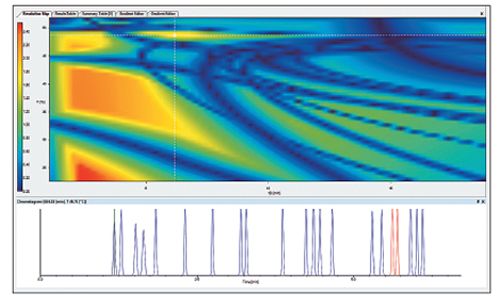
Efficient HPLC Method Development
This article describes the method development and optimization of a fast and simple HPLC-MS assay for the separation, qualification, and quantification of common pesticides.
For the development of a fast and reliable LC-MS screening method for residual pesticides, a Shimadzu Nexera X2 Method Scouting System was used, consisting of two quaternary solvent pumps (LC-30AD), a 20 µL solvent mixer, an autosampler (SILâ30AC), and a column oven (CTO-20AC) including a six column switching valve (FCV-34AH). The system was also equipped with a Shimadzu LCMS-2020 single quadrupole mass spectrometer via an ESI source. The different mobile and stationary phases used for method scouting for the separation of 20 common pesticides are displayed in Table 1.
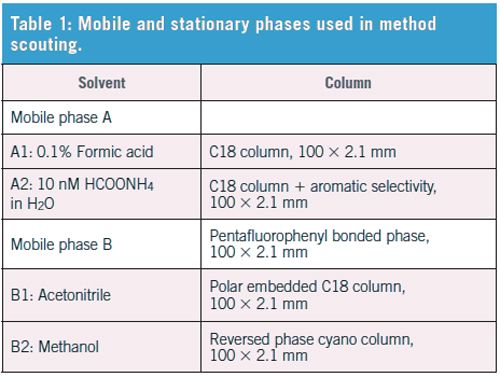
Method scouting was performed in an overnight sequence using gradient runs from 10 to 98% B in 6 min at 40 °C with combinations of aqueous and organic mobile phases on the five columns specified in Table 1. The most promising mobile phase/stationary phase combination was then used for computer simulation using DryLab method optimization software to identify the optimum separation conditions with respect to gradient slope and oven temperature.
Results
A total of 40 different chromatographic conditions were evaluated for ideal separation and detection conditions. Best peak intensity, peak shape, and separation were obtained with a mobile phase combination of 0.1% formic acid and acetonitrile on the pentafluorophenyl bonded stationary phase. These conditions were used to create a two-dimensional DryLab model using 5 and 15 min gradient runs at 25 °C and 50 °C as input data. These experiments resulted in a colourâcoded resolution map for simple identification of the optimum separation conditions (Figure 1).
Figure 2: Typical chromatogram of the UHPLC analysis of pesticides as predicted by DryLab®.
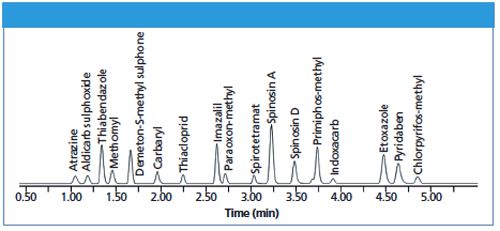
The software predicted an optimum separation with a minimum resolution of the critical peak pair of 1.6 in a gradient run from 10 to 75%B in 3 min at a flow rate of 0.5 mL/min at 35 °C.
Conclusion
The Nexera X2 method scouting system in combination with computer simulation software is an ideal tool for quick and efficient development of reliable, fast UHPLC methods. A robust, selective, and sensitive separation of 17 commonly used pesticides in 5 min was established successfully within two working days. The automated workflow starting with a method scouting experiment and further optimization using a computer simulation software package saved time and offered visualization of the design space in a resolution map to establish the most robust separation method. The use of highly sensitive and selective LC-MS detection was feasible using the ESI source and facilitated peak assignment.
Figure 3:
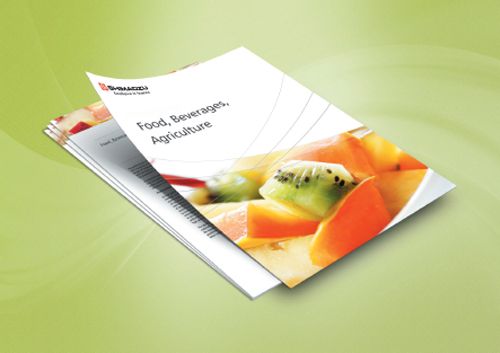
Application Handbook “Food, Beverages, Agriculture”.
The new Shimadzu Application Handbook “Food, Beverages, Agriculture” (Figure 3) combines real life applications and most advanced technologies and solutions on consumer and product safety. All major analytical instrumentation methods are covered, such as chromatography, mass spectrometry, spectroscopy, life science lab instruments, sum parameter (TOC/TN), and materials testing & inspection. Over 200 pages, “Food, Beverages, Agriculture” covers 58 real-life applications related to hot subjects such as food scandals, which have recently alarmed consumers all around the world. The book is free of charge and can be downloaded on http://www.shimadzu.eu/food-beverages-agriculture or by using the QR code.
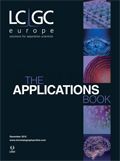
New Method Explored for the Detection of CECs in Crops Irrigated with Contaminated Water
April 30th 2025This new study presents a validated QuEChERS–LC-MS/MS method for detecting eight persistent, mobile, and toxic substances in escarole, tomatoes, and tomato leaves irrigated with contaminated water.

.png&w=3840&q=75)

.png&w=3840&q=75)



.png&w=3840&q=75)



.png&w=3840&q=75)










